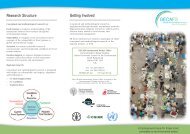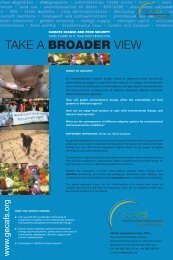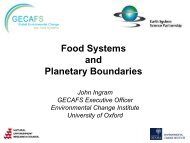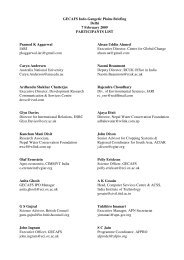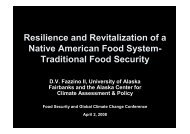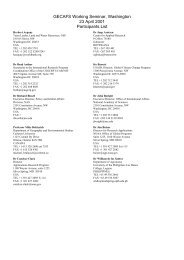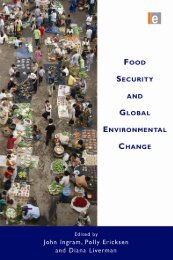Importance of this type of research and its impact on the science agendaThe need for interdisciplinary, even trans-disciplinary, approaches for food security researchis now well accepted (Liverman and Kapadia, 2010; UK <strong>Global</strong> <strong>Food</strong> <strong>Security</strong> Programme,2011). Indeed, food security research provides an excellent example of the need for muchenhanced interdisciplinarity, with social science, economics and the humanities all playingcritical roles in addition <strong>to</strong> the biophysical sciences. As Pálsson et al. (2011) state “Acceptingthat food systems encompass social, cultural, economic and political issues, as well asbiophysical aspects, acknowledges contributions of different disciplines. However, inbridging disciplines we must recognize the importance of framing these systems whendevising appropriate management interventions, development strategies, and policies”.The value of the ‘systems’ approach for research on food securityIn addition <strong>to</strong> underscoring the need for contributions from a range of disciplines, theGECAFS food systems approach introduced in Paper 1, and elaborated upon in Paper 3,engenders a greatly enhanced discussion on food security. Paper 3 also documents a range ofcase studies where the approach has been helpful in planning and undertaking research. Thework in these examples stems from a number of more fundamental impacts on the scienceagenda:First, and as Ericksen summarises in Ingram et al. (2010), the food systems approach framesthe food system activities as “dynamic and interacting processes embedded in social,political, economic, his<strong>to</strong>rical and environmental contexts”. It thereby relates the food systemactivities of producing food, processing, distributing and retailing, and consuming food (the“what we do”) <strong>to</strong> the outcomes of these activities not only for food security and othersocioeconomic issues, but also on the environment (the “what we get”) (Paper 3, Figure 1).Clearly, this interconnected set of outcomes, and particularly as relating <strong>to</strong> food security,results from a complex set of interactions in multiple domains but these are often nothighlighted in conventional food chain analyses focusing on food yields and flows. Thestructured integration of the food chain and food security concepts was the key developmentin the Ericksen paper (2008a), and expanded upon in Paper 3.Second, by embedding this integrated concept within the socioeconomic and globalenvironmental change drivers and feedbacks discussion initiated in Paper 1, and developedfurther in Paper 3 (e.g. the ‘Planetary Boundaries’ example), this ‘food systems’ approachenhances the science agenda by explicitly considering feed-backs <strong>to</strong> both environmental andsocioeconomic conditions for given adaptation options – the “so what” question. This hasgreat policy relevance as the intended consequences (the ‘impact’), and (often moreimportantly) the unintended consequences of a given technical or policy intervention need <strong>to</strong>be carefully assessed. As Ericksen goes on <strong>to</strong> note, “feedbacks from food system activitiesare of a particular concern because they may have unintended, and often negative, social aswell as environmental consequences. This forces society <strong>to</strong> confront the trade-offs betweenkey ecosystem services and social welfare outcomes” (Ericksen, 2008a).108
This important point about feed-backs motivates analyses of the synergies and trade-offsbetween varied desired outcomes from food systems. This can be done most effectively if thebroad food system approach is adopted. It thus drove the development of a set of ‘feed-back’questions for the GECAFS regional science plans (GECAFS, 2006a; GECAFS, 2007;GECAFS, 2008) as research agendas had hither<strong>to</strong> generally been limited <strong>to</strong> the impacts ofGEC on food production, and the technical – and <strong>to</strong> some extent, policy – response options inthe agricultural domain. It is also a main feature of the scenarios analyses in CCAFS (CCAFSScenarios Team, 2010; and Paper 3) which are being developed <strong>to</strong> address the question “Howcan food security, livelihood and environmental goals all be met for a set of plausible futuresfor different regions of the world?”.Third, the food system approach helps frame discussions of vulnerability. Paper 1 introducesthe concepts of food system vulnerability, noting the important point that this is determinednot so much by the impact of stress, but by the combination of exposure <strong>to</strong> stress and thecapacity <strong>to</strong> cope with and recover from this stress. The fuller food system concept allows this<strong>to</strong> be developed further by defining exactly which aspect of the food system (i.e. whichactivity(s)) are vulnerable <strong>to</strong> what (cf. the India/Nepal example in Paper 3) and how thisaffects food security.Science contributions from integrating the food systems approach with scale conceptsWhile the ‘food systems’ approach thus enhances interdisciplinary science agendas in severalways, its real value comes in helping <strong>to</strong> understand the interactions between the multiplescales and levels thereon which characterise how food systems operate in practice.Gibson et al. (2000) define ‘scale’ as the spatial, temporal, quantitative, or analyticaldimensions used <strong>to</strong> measure and study any phenomenon, and ‘levels’ as the units of analysisthat are located at different positions on a scale. Cash et al. (2006) build on this, notingspatial, temporal, jurisdictional, institutional, management scales, and the need <strong>to</strong> recognisethe importance of interactions between levels along each of these (e.g. from local <strong>to</strong> global, orseasonal <strong>to</strong> decadal). <strong>Food</strong> security issues span a number of different scales and, as noted inPaper 3, a predominant feature of 21 st Century food systems is that they are inherently crossleveland cross-scale.The importance of spatial, temporal, jurisdictional and other scales and scaling asdetermining fac<strong>to</strong>rs in many environmental and food security problems is now wellrecognised, and both scientists and policy makers are increasingly aware that findingsolutions requires consideration of various scales. This is particularly important in relation <strong>to</strong>governance of complex socio-ecological systems (as exemplified in food systems), andespecially as they are dynamic; governance, policies and planning have <strong>to</strong> consider multipletime levels (“… all people, at all times, have physical and economic access …”, (FAO,1996b).109
- Page 1 and 2:
From Food Production to Food Securi
- Page 3 and 4:
From Food Production to Food Securi
- Page 5 and 6:
Table of ContentsAbstract .........
- Page 7 and 8:
Paper 6: Undertaking Research at th
- Page 9:
AbstractFood security is a conditio
- Page 12 and 13:
2010 about 925 million people had t
- Page 14 and 15:
water) are used, and reduce negativ
- Page 16 and 17:
While the flow of the argument abou
- Page 18 and 19:
determine interactions along and be
- Page 20 and 21:
Paper 3: A Food Systems Approach to
- Page 23:
From Food Production to Food Securi
- Page 26 and 27:
concerns and are now issues that mu
- Page 28 and 29:
the relationships between GEC and f
- Page 30 and 31:
Theme 2 aims to understand how comm
- Page 32 and 33:
GEC and the Food System of the Indo
- Page 34 and 35:
Paper 2: The role of agronomic rese
- Page 36 and 37:
These advances have resulted from a
- Page 38 and 39:
Crop selection to determine mechani
- Page 40 and 41:
Agronomic science is central to imp
- Page 42 and 43:
Agronomic research in relation to f
- Page 44 and 45:
The discussion above identifies a n
- Page 46 and 47:
interventions and political inertia
- Page 48 and 49:
While research on producing food ha
- Page 50 and 51:
Box 1 Food system Activities and fo
- Page 52 and 53:
In addition to broadening the debat
- Page 54 and 55:
options. Examples already seen rang
- Page 56 and 57:
Figure 3 Outcomes for 10 variables
- Page 58 and 59:
Figure 4 Nine ‘planetary boundari
- Page 60 and 61:
Figure 5 Environmental change, food
- Page 62 and 63:
Table 1: Indicative analysis of the
- Page 65:
From Food Production to Food Securi
- Page 68 and 69: Trade Agreement (NAFTA) and the Eur
- Page 70 and 71: Parry et al., 2005). Conducting foo
- Page 72 and 73: is provided in the ESF/COST Forward
- Page 74 and 75: Paper 5: Engaging Stakeholders at t
- Page 76 and 77: into actions (strategies, policies,
- Page 78 and 79: Box 2 Engaging with stakeholders in
- Page 80 and 81: Box 3 Setting the research agenda f
- Page 82 and 83: Third, and of considerable practica
- Page 84 and 85: Figure 2: Organizing and understand
- Page 86 and 87: organizations made up of numerous n
- Page 88 and 89: Elements of good practice in stakeh
- Page 90 and 91: Finally, it is worth noting that fo
- Page 92 and 93: development (Lee, 1999; Gunderson a
- Page 94 and 95: Box 7 The GECAFS stakeholder survey
- Page 96 and 97: ‘break down’ what might be a hi
- Page 98 and 99: Paper 6: Undertaking Research at th
- Page 100 and 101: agriculture in many parts of the wo
- Page 102 and 103: gaps. The presence of a strong tech
- Page 104 and 105: an average of two years to coalesce
- Page 106 and 107: Institute for Meteorology and Hydro
- Page 108 and 109: Identifying case study sitesResearc
- Page 110 and 111: can both benefit from and contribut
- Page 112 and 113: Box 5 Mapping stakeholder interests
- Page 114 and 115: Holding planning meetings in locati
- Page 116 and 117: This reorientation of the debate fr
- Page 120 and 121: Integrating the food system concept
- Page 122 and 123: awareness of the GEC issues within
- Page 124 and 125: pollutants were then introduced as
- Page 126 and 127: communities operating in food syste
- Page 128 and 129: Improving input-use efficiency acro
- Page 130 and 131: governance focuses on the range of
- Page 132 and 133: Developing research agendas in supp
- Page 134 and 135: The renewed approach to interdiscip
- Page 136 and 137: BIELAK, A., HOLMES, J., SAVGÅRD, J
- Page 138 and 139: EAKIN, H. 2010. What is Vulnerable?
- Page 140 and 141: GODFRAY, H. C. J., BEDDINGTON, J. R
- Page 142 and 143: INGRAM, J. S. I. & FERNANDES, E. C.
- Page 144 and 145: LYUTSE, S. 2010. The One Billion To
- Page 146 and 147: RAYNER, S. & MALONE, E. L. 1998. Hu
- Page 148 and 149: UNDP 2006. The 2006 Human Developme
- Page 150 and 151: activities “from plough to plate
- Page 152 and 153: contribution to the science agenda:
- Page 154 and 155: urgently needed, and - given the gr
- Page 156 and 157: GECAFS plannenmakerij stelde vast d
- Page 158 and 159: ieder hun eigen groep van betrokken
- Page 160 and 161: het gebied van beheer hebben betrek
- Page 162: Curriculum VitaeFollowing a BSc in



